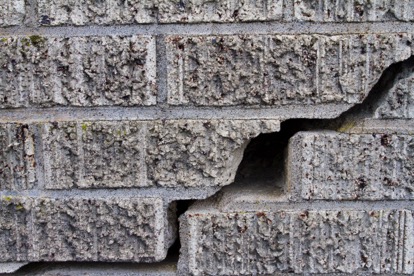Any cracking identified within a building can cause great concern and fear for its owner or potential buyer. The Royal Institution of Chartered Surveyors (RICS) recommends that if you’re not happy with an insurance company’s post-investigation conclusion, you should get advice from an independent party in the form of a surveyor. Here at London Building Surveyors we implement great care and caution when diagnosing this problem in order to offer the correct guidance and solution for our clients. It is important to establish whether the cracking is likely to be progressive and to deteriorate further, and if so, to what extent and over what period of time.
Causes of cracking in buildings
Cracking in a building or structure can appear for a variety of reasons and sometimes a combination of factors can contribute to the problem. The appearance of cracks can impact on the value of the building, its insurability and the saleability.
Here we look at some of the most common causes:
Permeability of concrete
Corrosion in concrete can occur due to various aggressive agents and low permeability is the key to its durability. Permeability of concrete is directly related to its water-to-cement ratio—the lower the water- to-cement ratio, the lower the permeability of the concrete. The requirements are very much based on the buildings exposure to elements such as chlorides, chemicals, salt and moisture.
Thermal movement
Thermal movement is caused by the expansion and contraction of the fabric of the building due to hot and cold weather. When it’s hot the masonry expands causing compressive forces. The masonry tends to cope with this due to its high compression strength, but once it’s cold, the material shrinks with malleable force and this can cause cracking. These small fractures can eventually develop into large cracks if the problem is not identified and dealt with appropriately.
Moisture movement
Most buildings are constructed with materials that expand when absorbing moisture and shrink on drying. Moisture inevitably moves through your building due to factors such as rain, water vapour and ground water. Exposure to wet/dry cyclic periods can cause moisture shrinkage, especially in concrete and calcium-silicate masonry. This movement causes tension that can result in your structure developing cracks.
Subsidence
Subsidence is when your buildings foundations move. Shallow foundations, clay sub-soil, tree roots and dry weather are a combination that can make subsidence a real danger. According to Which? Around 70% of subsidence cases are due to tree roots. There could be movement in the ground beneath your home if you find new or expanding cracks in plasterwork or outside brickwork.
Wall tie failure
This occurs when the metal ties holding the outside skin of both solid and cavity walls fail. Rusting often causes metal ties to expand, triggering horizontal cracking in the mortar joints. Other explanations include poor quality mortar reducing the bond between the tie and mortar, or not installing the necessary number of ties.
Contact London Building Surveyors
Poor workmanship is often the explanation for the above causes. Not building to design specifications and poor mixing of building materials can have huge repercussions and result in cracking to your building or structure.
The identification and diagnosis of cracking in buildings is essential and misdiagnosis is common. This problem can get progressively worse so if you have any concerns we recommend seeking professional advice at the earliest opportunity.
If you would like to discuss this in more detail, please contact us today and one of our staff will be happy to offer practical advice and recommend the appropriate specialist.
